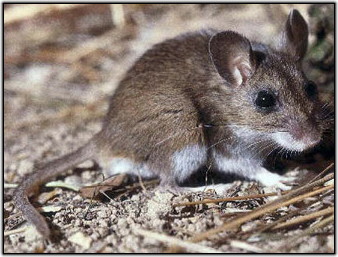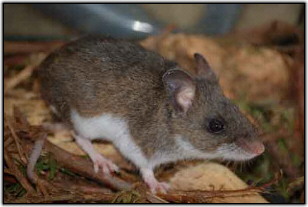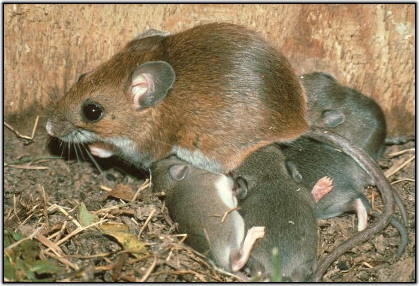Deer Mouse
 The deer mouse is a small, white-footed mouse with large dark eyes and long whiskers. The tail is relatively long and sharply bicolored, white beneath and dark above. The soft fur of the deer mouse varies in colour from a golden brown to a pale grey on the back, while the underparts are white, including the underside of the tail. The ears are large, round, and are covered with fine hairs; and can be described as ‘Mickey Mouse’-like. Deer mice have four toes on the forefeet and five toes on the hind feet. Adult deer mice weigh from 10 to 35 grams with external measurements averaging 17mm for total length, 81mm for the tail, 20mm for the hind foot, with the ear measuring between twelve to 20mm.
The deer mouse is a small, white-footed mouse with large dark eyes and long whiskers. The tail is relatively long and sharply bicolored, white beneath and dark above. The soft fur of the deer mouse varies in colour from a golden brown to a pale grey on the back, while the underparts are white, including the underside of the tail. The ears are large, round, and are covered with fine hairs; and can be described as ‘Mickey Mouse’-like. Deer mice have four toes on the forefeet and five toes on the hind feet. Adult deer mice weigh from 10 to 35 grams with external measurements averaging 17mm for total length, 81mm for the tail, 20mm for the hind foot, with the ear measuring between twelve to 20mm.
 Habitat
Habitat
The deer mouse is found throughout BC and indeed can be found all over North America. It can be found in forests, prairies, and deserts, but is not found where the ground is continually wet. Deer mice do not usually occur in urban areas. Their natural habitat is in rural and semi-rural areas, where they inhabit fields, pastures, and various types of vegetation found around homes and outbuildings.
The Deer mouse builds a spherical nest by shredding materials such as bark, grass, hair, string, and the fluff from cattails into a soft, warm bed with one main entrance. The nesting site can be found anywhere where there is a cavity or opening such as under rocks or wood piles, or in empty bird’s nests. Deer mice drop their scats and urinate in and around the nest site. Because of this there should always be a concern about Hantavirus whenever the Deer mouse is found in sheds, attics, feed bins, or other enclosed spaces were people may breathe the dust from the nest.
 Breeding
Breeding
Breeding starts very late in the winter and young are then born in April, they have many litters each from two to nine. On average, the deer mouse has about four litters each year. The gestation period varies from 22 to 27 days, averaging about 24 days.
Litter size ranges from one to nine, averaging about four. At birth the young are blind, pink, and hairless and weigh from 1.1 to 2.3 grams. The male while not present at birth, does return to assists in the care of the young. Sexual maturity is reached before the young lose their “blue” juvenile pelage, and females born early in the year may themselves produce young by late summer or early fall.
The deer mouse is omnivorous, and feeds on seeds, plant greens, berries, nuts, mushrooms, insects, and carrion. They will also gnaw on bones or antlers for the calcium.
Deer mice in turn are an important food source for many carnivores, like weasels, foxes, skunks, minks, raccoons, bears, coyotes, and wolves. Owls and snakes are also important predators.
DOWNLOAD MORE INFO ON THE SPCA’S BEST PRACTICES FOR MICE & RATS

